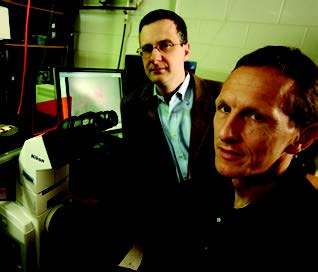With the tiniest particles, probes, and therapeutic agents, Johns Hopkins nanobiotechnology researchers are set to supersize their efforts to advance medicine, engineering, biology, and public health.
NANOTECHNOLOGY IS A PARADOX, for even the smallest bit of matter can have the most profound impact. Thanks to silicon, ever-smaller manufacturing technology has revolutionized electronics. The next frontier in which tiny will triumph—nanobiotechnology—is poised to bring similarly remarkable results.
One-billionth of a meter: It’s hard even to imagine something that size. A nanometer (nm) is 1,000 times smaller than you can see in a conventional optical microscope. A nanoparticle might be only 50 atoms in diameter. Nanowires are less than 100 nm in diameter. As probes, carriers, and therapeutic agents, nano-engineered tools can be deployed to specific places or perform specific tasks.
At the Johns Hopkins Institute for NanoBioTechnology (INBT), researchers are planning something very big for these small particles and tools. INBT launched in mid-May with a celebration and $6 million in start-up funding from the National Science Foundation, the Howard Hughes Medical Institute, NASA, and Hopkins.
The INBT reaches deeply into four divisions of the University—the Bloomberg School of Public Health, the Krieger School of Arts and Sciences, the School of Medicine, and the Whiting School of Engineering. From these schools, INBT has created a completely new model for interdisciplinary research, an accelerated schedule for transferring new technologies into successful companies, and even a new kind of learning. This learning will be geared to the intensely interdisciplinary, market-savvy needs of biotechnology—the science and the business. A minor in nanobiotechnology already is being planned for undergraduates in the Whiting and Krieger schools.
As the new institute stretches across the fields of biology, engineering, public health, and medicine, here are just a few examples of the possibilities the INBT will create:
- less-invasive medical diagnostics,
- nanostructures compatible with living tissue,
- quantum dots (fluorescent semiconductor nanocrystals) that can recognize genetic and molecular events. Covering with specific ligands, for example, they could be used to track the movements or monitor the function of specific proteins and enzymes in real time, or one molecule at a time;
- multifunctional nanoparticles that combine into one vehicle molecular recognition, a therapeutic agent, and a reporter or contrast agent. Among the ones INBT researchers have been studying are two-segment nanorods functionalized with a cell receptor and DNA.
“We envision the Hopkins INBT becoming the leading center for nanobiotechnology research, for the development of new diagnostics and therapeutics, and for addressing the public health issues raised by nanobiotechnology.”Peter C. Searson

“The INBT will have a huge impact and involve a large number of people at Hopkins,” says Peter C. Searson, who is the institute’s director and a professor in the Whiting School’s Department of Materials Science and Engineering. In his own research group, Searson and his team synthesize and assemble nanostructured materials with unusual electronic and magnetic properties.
In part, INBT “illustrates why Hopkins is one of the few institutions capable of pulling together such a large group of people from diverse disciplines,” Searson notes. In the fall of 2004, when an e-mail survey was sent to gauge interest in the proposed institute, there was an enormous response—more than 80 faculty members across disciplines. Since then, the various academic units have been lining up the contributions they can make to further its aims.
The institute’s goals are to “establish Hopkins as a world leader in nanobiotechnology; provide infrastructure that links faculty in ways that can significantly increase funding in this area; create programs that integrate research, education, and technology transfer; and become financially self-sufficient,” Searson explains.
“Hopkins has two resources essential to creating a successful institute: a large number of outstanding faculty with relevant expertise, plus world-class research facilities.” All that’s needed, he believes, is “the infrastructure to harness our resources.”
The INBT’s Four Frontiers
Capitalizing on the interest and skills of researchers from across Hopkins, the INBT focuses on four interconnected thrust areas:
- molecular and cellular dynamics (MCD),
- diagnostics,
- therapeutics, and
- health and the environment.
Nanotechnology applied to MCD refers to the development of biological interventions at the molecular scale for investigating biological functions in living cells and animals, and ultimately for curing diseases.
In the area of diagnostics, recent advances in the development of engineered nanoparticles, coupled with advances in molecular imaging research (MIR), are driving an explosion in nanobiotechnology imaging research. “Key to those advances is the emergence of functionalized nanoparticles that can be targeted specifically to receptors, enzymes, transporters, and other molecules of biological importance,” Searson explains.
The third thrust area, therapeutics, takes the next step: It will explore how nanoparticles can be given multiple functions engineered to recognize a diseased organ and specifically target that organ to deliver a drug, gene, or gene product in a controlled manner.
In the fourth area, human health and the environment, the lack of understanding about nanotechnology’s implications is calling for concentrated work on how human activity has impacted the environment. For with all their therapeutic potential, nanoparticles also have potential risks because they may contain toxins. Their ultra-fine size, along with their larger surface area per unit mass, increase the risk of these toxins reaching lungs and other organs.
“We envision the Hopkins INBT becoming the leading center for nanobiotechnology research, for the development of new diagnostics and therapeutics, and for addressing the public health issues raised by nanobiotechnology,” says Searson.
There is growing recognition that “the impact of nanotechnology is probably going to be greatest in biology and medicine,” Searson notes. “Some are even beginning to refer to ‘nanomedicine’ to describe this nexus of research disciplines, technologies, and clinical solutions.” Soon, he predicts, the INBT will have the potential to set Hopkins apart as a global research and development leader in yet another area—one that some consider will usher in the next great age of medicine. Engineering will provide its own R&D to this nano-area. And that’s no small thing.
Learn more about the Institute for NanoBioTechnology at inbt.jhu.edu.




